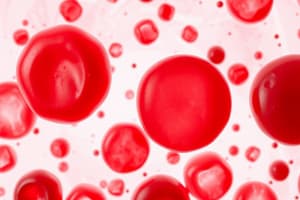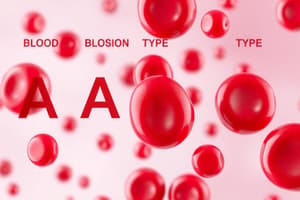Podcast
Questions and Answers
Karl Landsteiner discovered that blood can be classified by its __.
Karl Landsteiner discovered that blood can be classified by its __.
type
No two individuals, except for identical twins, can be expected to have the same combination of blood types or antigens.
No two individuals, except for identical twins, can be expected to have the same combination of blood types or antigens.
True (A)
__ is the fluid portion of unclotted blood.
__ is the fluid portion of unclotted blood.
Plasma
The liquid that separates from the blood when a clot is formed is called the __.
The liquid that separates from the blood when a clot is formed is called the __.
__ transport oxygen from the lungs to the body tissues and carry carbon dioxide back to the lungs.
__ transport oxygen from the lungs to the body tissues and carry carbon dioxide back to the lungs.
On the surface of red blood cells are chemical substances called __, which impart blood type characteristics to the cells.
On the surface of red blood cells are chemical substances called __, which impart blood type characteristics to the cells.
Type A individuals have __ antigens on the surface of their red blood cells.
Type A individuals have __ antigens on the surface of their red blood cells.
Type O individuals have neither A nor B antigens on their red blood cells.
Type O individuals have neither A nor B antigens on their red blood cells.
The presence or absence of the __ and ___ antigens on the red blood cells determines a person's blood type in the A-B-O system.
The presence or absence of the __ and ___ antigens on the red blood cells determines a person's blood type in the A-B-O system.
The D antigen is also known as the __ antigen.
The D antigen is also known as the __ antigen.
Serum contains proteins known as __, which destroy or inactivate antigens.
Serum contains proteins known as __, which destroy or inactivate antigens.
An antibody reacts only with a specific antigen.
An antibody reacts only with a specific antigen.
Agglutination describes the clumping together of red blood cells by the action of an antibody.
Agglutination describes the clumping together of red blood cells by the action of an antibody.
Type B blood contains __ antigens and anti__ antibodies.
Type B blood contains __ antigens and anti__ antibodies.
Type AB blood has neither anti-A nor anti-B antibodies.
Type AB blood has neither anti-A nor anti-B antibodies.
A drug-protein complex can be injected into an animal to form specific __ for that drug.
A drug-protein complex can be injected into an animal to form specific __ for that drug.
The term __ describes the study of antigen-antibody reactions.
The term __ describes the study of antigen-antibody reactions.
Type AB blood is agglutinated by both anti-A/anti-B serum.
Type AB blood is agglutinated by both anti-A/anti-B serum.
Type B red blood cells agglutinate when added to type A blood.
Type B red blood cells agglutinate when added to type A blood.
Type A blood cells agglutinate when added to type __ blood.
Type A blood cells agglutinate when added to type __ blood.
The distribution of type A blood in the US is approximately __%.
The distribution of type A blood in the US is approximately __%.
The distribution of type AB blood in the US is approximately __%.
The distribution of type AB blood in the US is approximately __%.
Most blood hemoglobin has peroxidase-like activity.
Most blood hemoglobin has peroxidase-like activity.
For many years, the most commonly used color test for identifying blood has the __ color test.
For many years, the most commonly used color test for identifying blood has the __ color test.
__ reagent reacts with blood, causing it to luminesce.
__ reagent reacts with blood, causing it to luminesce.
Blood can be characterized as being of human origin by __ test.
Blood can be characterized as being of human origin by __ test.
Antigens and antibodies can be induced to move toward each other under the influence of an electrical field.
Antigens and antibodies can be induced to move toward each other under the influence of an electrical field.
The basic unit of heredity is the __.
The basic unit of heredity is the __.
Genes are positioned on threadlike bodies called __.
Genes are positioned on threadlike bodies called __.
All nucleated cells in the human body, except the reproductive cells have __ pairs of chromosomes.
All nucleated cells in the human body, except the reproductive cells have __ pairs of chromosomes.
The sex of an offspring is always determined by the __.
The sex of an offspring is always determined by the __.
Genes that influence a given characteristic and are aligned with one another on a chromosome pair are known as __.
Genes that influence a given characteristic and are aligned with one another on a chromosome pair are known as __.
When a pair of allelic genes is identical, the genes are said to be __.
When a pair of allelic genes is identical, the genes are said to be __.
The __ color test is used to locate and characterize seminal stains.
The __ color test is used to locate and characterize seminal stains.
Semen is unequivocally identified by the microscopic appearance of __.
Semen is unequivocally identified by the microscopic appearance of __.
Males with a low sperm count have a condition known as __.
Males with a low sperm count have a condition known as __.
The protein __ is useful for the characterization of semen.
The protein __ is useful for the characterization of semen.
DNA may be transferred to an object through the medium perspiration.
DNA may be transferred to an object through the medium perspiration.
Seminal constituents may remain in the vagina for up to six days after intercourse.
Seminal constituents may remain in the vagina for up to six days after intercourse.
Flashcards are hidden until you start studying
Study Notes
Blood Classification and Components
- Karl Landsteiner discovered blood can be classified by type.
- Plasma is the fluid portion of unclotted blood, while serum separates from blood when a clot forms.
- Red blood cells transport oxygen and carbon dioxide between the lungs and body tissues.
- Antigens are chemical substances on red blood cells that determine blood type characteristics.
Blood Types and Antigens
- Type A individuals possess A antigens on red blood cells.
- Type O individuals lack A and B antigens.
- The A-B-O blood type system is determined by the presence or absence of A and B antigens.
- The D antigen is also referred to as the Rh antigen.
Antibodies and Immunity
- Serum contains antibodies, which specifically target and inactivate antigens.
- Antibodies react only with their corresponding antigens, facilitating agglutination, the clumping of red blood cells.
- Type B blood has B antigens and anti-A antibodies; Type AB blood has neither anti-A nor anti-B antibodies.
Blood Typing and Agglutination
- Type AB blood is agglutinated by both anti-A and anti-B serum.
- Type B red blood cells agglutinate when mixed with Type A blood.
- Type A red blood cells agglutinate when mixed with Type B blood.
Blood Type Distribution
- Approximately 42% of the US population has Type A blood.
- Type AB blood is present in about 3% of the US population.
Blood Analysis Techniques
- Hemoglobin in blood exhibits peroxidase-like activity and can be analyzed using the benzidine color test for blood identification.
- Luminol reagent causes blood to luminesce, aiding in detection.
- Precipitin tests determine whether blood is of human origin.
Genetics and Heredity
- The gene is the basic unit of heredity, located on chromosomes, which are threadlike structures.
- Humans typically have 23 pairs of chromosomes in all nucleated cells, excluding reproductive cells.
- A child’s sex is determined by the father.
- Alleles are genes influencing specific characteristics located on chromosome pairs, and they can be homozygous (identical genes).
Semen and Reproductive Biology
- The acid phosphatase color test is used to locate and characterize seminal stains.
- Semen is identifiable microscopically by the presence of spermatozoa.
- A low sperm count in males is termed oligospermia.
- Prostate-specific antigen (p30) helps characterize semen.
DNA Transfer
- DNA can be transferred via perspiration, indicating the presence of genetic material.
- Seminal constituents can remain in the vagina for up to 6 hours after intercourse.
Studying That Suits You
Use AI to generate personalized quizzes and flashcards to suit your learning preferences.




